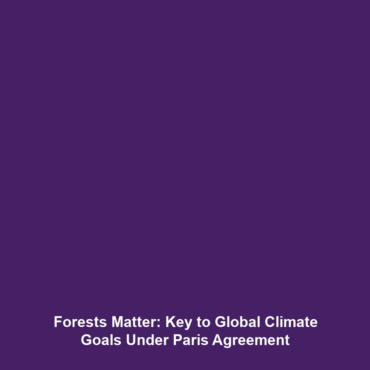How Protecting and Restoring Forests is Critical for Meeting Global Climate Commitments Under the Paris Agreement
Introduction
Protecting and restoring forests plays a vital role in mitigating climate change and preserving biodiversity. With deforestation contributing significantly to carbon emissions, forests act as crucial carbon sinks. The significance of addressing deforestation and restoring forest ecosystems cannot be overstated, especially in the context of meeting the global climate commitments established under the Paris Agreement. This article explores the fundamental connections between forest conservation and climate goals, highlighting the critical nature of forest protection in combating biodiversity loss.
Key Concepts
Central to understanding the relationship between forest conservation and climate commitments is the concept of carbon sequestration. Forests absorb carbon dioxide from the atmosphere, thus helping to mitigate greenhouse gas emissions. Additionally, the following principles are important:
- Deforestation: The permanent removal of forests, leading to loss of biodiversity and increased CO2 levels.
- Biodiversity Enhancement: Healthy forests support diverse ecosystems, which are crucial for resilience against climate change.
- Restoration Efforts: Initiatives aimed at reforesting damaged areas, crucial for rebuilding ecosystems and advancing sustainability goals.
Applications and Real-World Uses
The applications of protecting and restoring forests are extensive, particularly in the context of climate action and combating biodiversity loss. Here are several significant uses:
- Carbon Trading Schemes: Programs that incentivize forest conservation in exchange for carbon credits.
- Agroforestry: Integrating trees into agricultural practices to enhance biodiversity while maintaining crop yields.
- Ecotourism: Promoting forest conservation while generating income through tourism that respects ecological integrity.
Current Challenges
Several challenges persist in the efforts to protect and restore forests amid the ongoing deforestation crisis:
- Legislative Barriers: Inadequate policies can hinder effective conservation efforts.
- Funding Shortages: Limited financial resources deter large-scale restoration projects.
- Land-Use Conflicts: Competing interests between agricultural expansion and forest conservation create tension in safeguarding ecosystems.
Future Research and Innovations
Looking ahead, future research and innovations in forest conservation are likely to focus on:
- Advanced remote sensing technologies to monitor forest health and biomass.
- Genetic research aimed at enhancing the resilience of tree species to climate change.
- Collaboration between nations for global forest strategy frameworks that align with Paris Agreement goals.
Conclusion
In conclusion, protecting and restoring forests are imperative actions necessary for meeting global climate commitments under the Paris Agreement and addressing deforestation and biodiversity loss. The interconnectedness of forests with carbon capture, biodiversity, and climate stability emphasizes the urgent need for concerted efforts in conservation. As individuals and communities, we can contribute to forest protection initiatives. For further exploration of related topics, consider reading about climate action strategies or the importance of biodiversity conservation.

